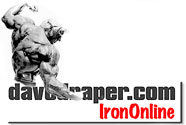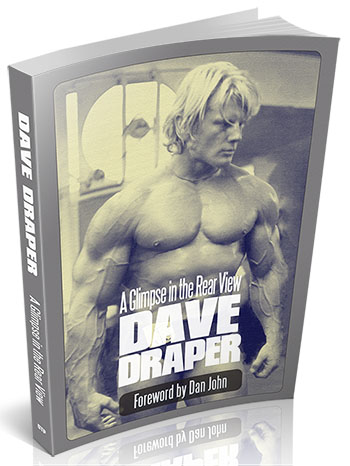Take Five on Me

Download the full Draper here newsletter
in printable, live-link, pdf format, here.
It's been a crazy week. I was just thumbing through the archives looking for topic ideas and instead grabbed a fistful of classic "questions and answers" collected over the months that make for easy reading and writing. We both need a break.
So sit back, put your feet up and take five on me.
Q)
When you and your fellow bodybuilders were all competing in the '60s, Schwarzenegger, Zane, Columbo, Ferrigno and Reg Park, how could you all train together in the same gym and even socialize outside and still maintain a winning attitude, even though you were all competing to beat each other?
A)
Long story made short: It was more than 50 years ago; the lifting crowd was smaller and we were sharing a relatively young and unexploited sport. Early bodybuilders were like brisk stallions in the rough country before fences, corrals and stalls, bits, harnesses and saddles.
We were young and excited about the robust and undeveloped activity. Odd friends in an area of emerging expression, we enjoyed and needed each other's supporting interest, companionship, unspoken understanding and mutual admiration, collective motivations and rare character composition.
Times have changed, the world has changed. We lucked out.
Q)
I feel a sense of urgency in my training, since I'm almost 50 and have no time to waste. All the training splits and techniques I've read about only confuse me. Since you and Arnold are my idea of what a bodybuilder should look like, can you tell me if you used the push-pull split system or chest & back, shoulders & arms and legs split?
A)
Relax and be strong. All forms of training are effective when done with focus and responsible intensity. You are not losing ground while applying any one of them for a significant period to enjoy or determine their results. Like Zabo, my Muscle Beach bud, always said, "It's all good."
I like the chest & back, shoulders & arms and legs split. I like push/pull supersets. I like to blast it with focus, form and solid pace. I like to feel the muscles work and know the work the muscles do. I don't personally like HIT styles of training or the intensity methodologies where one trains to miserable, blacking-out, crawling-in-your-vomit failure once or twice a week. I must be crazy.
Why don't you stick to Brother Iron Sister Steel for your guidance? It's one source by one humble spokesman of the Muscle Beach and Golden Era of bodybuilding.
A few more things: Urgency causes catabolism and you're still a kid. Redirect that urgency into a positive training intensity, young fella.
Q)
What are your eating habits before you hit the weights?
A)
Easy: I have a protein drink (12-16 ounces) some 30 minutes prior to my workout, consisting of 2% milk, half of a banana, a raw fertile egg from well fed and carefully maintained chickens, and three scoops of Bomber Blend, my favorite protein powder.
I trust this nutritious concoction with my body's previously stored glycogen to supply my energy and anabolic needs without uncomfortable bloating or overloading the digestive system.
I make sure I'm hydrated and tote a bottle of water around the gym floor. I'm also confident of the creatine and vitamin & mineral content in my system through regular daily supplementation.
Meals of protein, fats and carbs best serve the body's energy and growth needs when eaten every three hours. Training later in the day generally assures more nutrient storage available for training support. Early morning workouts may call for a late-night feeding to load up the carb storage to serve the intense morning exertion.
Don't get confused by the nutritional aspects of eating and muscle building. The simple regulations found in Brother Iron say all we need to know without having us babbling to ourselves and drooling in the corner.
Q)
I've recently become a volunteer instructor for a high school weight room. Many of the teens overload the bar, their legs are not steady as they squat, and some complain that their backs always hurt after lifting. I recommend they drop the weight, work on form and then add weight slowly. Should I also add hip flexor exercises to their efforts or some other exercises to stabilize their hips?
A)
You have your hands full trying to bridle teens who feel invincible, are inexperienced and untrained and want muscle and might now. It's easy to gain their attention, but it takes time and continuous coaching to establish devotion, discipline and exercise understanding. In volunteer situations and casual settings these qualities are not generally developed, or in clear view.
Here's a list of tips and a selection of advantageous exercises to set firm foundations and avoid injuries:
~ Regular training and sport participation, if performed smartly, will condition the body and reduce the potential for injury and muscle discomfort. Your young friends are getting closer, yet they are not quite strong enough to support the weight they're handling. The sooner they accept that clean exercise execution and muscle engagement is more important than the amount of weight used, the happier, safer and cooler they will be, and the more quickly they'll achieve esteemed power and muscle development without injury and frustration.
~ Running track and doing sprints -- not as a sport necessarily, but in purposeful moderation -- is a fun and efficacious method to condition the musculature and cardiovascular systems of young athletes and fitness seekers (and older ones too).
~ Leg raises and hanging leg raises support the midsection and work the hip flexors.
~ Use light-weight deadlifts with proper form to build lower back and thighs and hams and glutes (3 or 4 sets x 6-8 reps).
~ Because young guys love benching, use perfect-form bench presses in sets of 8-10 reps with 80 percent output of effort -- no arching, bouncing or uneven-bar repetitions. Seeking maximum weight or resistance is tantamount to seeking shoulder injury. These serve the tris, anterior delt, minor pec and support an unspecified upper torso thickening.
~ Bring on dumbbell pressing on all levels of incline for chest, delts and some triceps. Dumbbells are safe, demanding and superb muscle builders.
~ I like standing barbell curls with moderate body thrust (3-4 x 10-8-6 reps) for biceps and torso strength.
~ Freehand dips and medium-to-wide-grip chins rock the lats and pecs and tris and delts.
Stick to the basic exercises that fully work the larger muscle groups and are responsible for fuller and more effective muscle growth. Exercise repetition is needed to gain the maximum an exercise has to offer. Changing exercises frequently for novelty is frivolous and defeats the purpose to grow in training understanding and muscle shape and might. Isolated secondary exercises are important for bodybuilders and are most beneficial at intermediate and advanced stages of training, although not necessarily for other athletes. They come just in time... later.
Q)
I am a personal trainer and one of my colleagues is going out for knee surgery on Monday. He is an avid lifter and is concerned about fitness loss and fat gain in the four to six weeks of recovery. Do you have any encouraging thoughts I can share with him?
A)
I'll bet your friend is back in the gym and shifting around the equipment sooner than he expects, and his down time will be an education -- a crash course in training modification -- invaluable to him, probably you and certainly for his clients. Experience is pricey. Accept the immediate let-down; be stoic, be strong and, as much as possible, relax, rather than stress about it. Welcome the rest -- we deserve and need it -- and then, applying wisdom, courage and intuition, ease into whatever action is desirable and doable while housebound -- sets of crawling and hobbling, dips, dynamic tension.
A walker or crutch would get me to a gym within a week unless the surgery was a major invasion. With the gym beneath our feet, no matter how shaky, we're able to keep our acts together. The ability to train the upper body will be altered, but not eliminated. And though the recovering leg injury is limiting, it's oddly easier to deal with emotionally and psychologically than an arm or a shoulder in a cast and sling.
Eat right, accounting for the fact that less food intake will be required for sustenance, yet maintenance of an anabolic environment is essential. Lay off the donuts and beer and Wonder bread, bub. Pray.
Legs come back fast. Good thing he's not a horse -- we'd have to shoot him.
Q)
Two years ago I was 352 pounds. Since then, I have lost 140 pounds. Now I have loose skin around the lower chest area. Is this something I will always have to deal with or will it tighten up eventually? What would you do?
A)
Wow! You're one of those rare and amazing people in the world who have overcome the near-impossible. Congratulations on the courage, discipline and hard work.
The loose skin around the pecs is a common problem of men over 40 with a heavy pectoral development. I'm staring the dilemma in the eye and seeking solutions. It's the age thing combined with gravity.
To counter the predicament, besides the ongoing struggle to eliminate overall body fat, do what you can to improve the muscle density of the pectoral region without adding muscle mass. Thus, don't do declines, as they only compound the lower-pec problem rather than solve it. Instead, I would focus on incline dumbbell work with both lower-rep, heavy-weight muscle-density training interwoven with lower-weight, higher-rep methodology for shaping and tucking. Here's where your finesse and creativity are summoned to determine a plan that is likeable and suitable for you.
I also like stiff-arm dumbbell pullovers, controlled flys, cable crossovers and dips leaning forward to engage the pecs. I suggest superset techniques to achieve muscularity and shape.
Aim your dietary sights toward lean muscle building -- higher protein, lower carb, medium fat. Bring in the extra vitamin C and minerals and essential fatty acids (EFAs). Love those fresh fruits and salads. These ingredients are known to improve the health and tone of the skin.
Consider your hormonal system, as low testosterone or high estrogen (or both, since they travel together) can account for fleshy pectoral development.
When the time is right and you have the courage, drop five or ten pounds to check your muscularity and skin tone. I don't think we have a lot more control than this. We try and we try again.
If nothing works, we try again.
Q)
I'm trying to bulk up and put on some muscle, yet I am active as construction worker and student. Do I need to work out less through the week, say four days a week?
A)
Training three days a week is good. Live right and rest often. Get your cardio-respiratory work from your hard training, squatting and deadlifting. Skip the aerobic exercise. Stick to the basics, take your time to condition, and don't get disheartened by work conflict. That's life and you'll blend the two deeds nicely if you're wise, industrious and committed.
Push the iron with affectionate might and be consistent. You'll win.
We're done here, winged warriors. You can go home now. Get some sleep... no hangin' in the hanger. Git... beat it... scram... vamoose... go... be gone.
Fly high and bye, bye...
Draper
*****
Take a trip over to our
Musclebuilding Q&A Blog
... where Dave allows us a peek into his email outbox.
Did you sign up for Dave's expanded email yet?
It's free, motivating and priceless!
We'll also send you a link to Dave's free
Body Revival Tips and Hints e-report with your confirmation notice.

